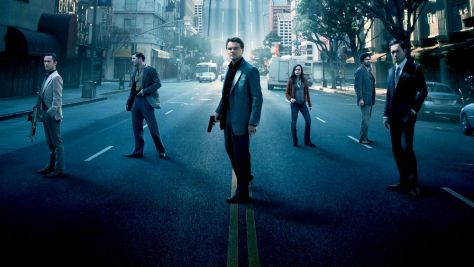 Every other month, we take a look at a movie from the Internet Movie Database’s List of the TOP 250 FILMS OF ALL-TIME. These are movies that transcend a simple “My Favorite Scene” column. These are movies that are hard to just pry five gems from, but we do and examine the film overall. We’re on our fourteenth installment in this series. Click on the link here to check out previous installments from #1 The Shawshank Redemption to #13 Forrest Gump.
Every other month, we take a look at a movie from the Internet Movie Database’s List of the TOP 250 FILMS OF ALL-TIME. These are movies that transcend a simple “My Favorite Scene” column. These are movies that are hard to just pry five gems from, but we do and examine the film overall. We’re on our fourteenth installment in this series. Click on the link here to check out previous installments from #1 The Shawshank Redemption to #13 Forrest Gump.
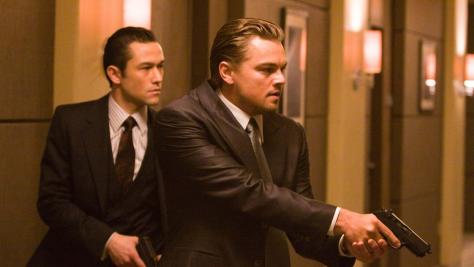
Inception is our fourteenth installment in this series, and what a perfect example of a film you simply cannot highlight in one scene. When Alfred Hitchcock was gone, everyone asked who would be the next Hitchcock. When Steven Spielberg lost his touch, people began asking who was the next Spielberg. Christopher Nolan isn’t the next anything. In an age when cinema has become largely cookie cutter, Nolan has risen to become film’s best director, and in 40 years people will be asking who the next Nolan will be. Inception is, in my opinion, Nolan’s best film, and a film so original and yet filled with so many classic elements of different genres that Nolan was able to make his dense script a hook audiences were willing to push themselves to understand. Combined with dazzling visuals, an amazing ensemble, Wally Pfister’s cinematography masterpiece, and a score from Hans Zimmer for the ages and you have one of the best films of the 21st Century.
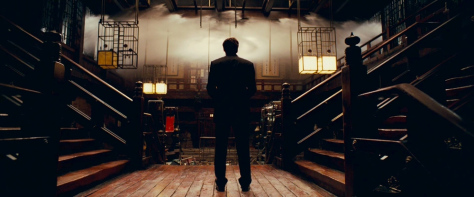
Dream thieves. How brilliant a concept is that? In an age where knowledge, data, and secrets are more valuable than gold, Nolan takes the traditional heist tropes of the “one last job”, “the assembling of the team”, etc. and adds the science fiction element of a device that allows this team of thieves to enter the subconscious of their victims. But that’s kicked on its head when the team is instead asked to place an idea inside their victim in a way he believes is his own, this requires a trip down so many rabbit holes and through multiple minds that I was delighted to find this map of the complexity of the team’s final job:
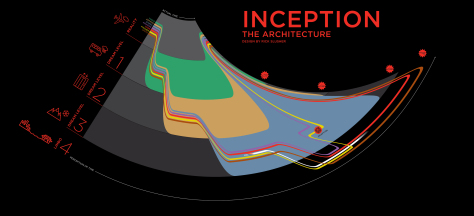
Inception is able to get away with such a cerebral conceit because the rules are laid out as the story builds, and the film is so stylish and action-packed that audience is willing to make the journey with Nolan. It is, as all of Nolan’s films are, ultimately about time: how it’s spent, how it’s wasted, how it’s manipulated, and how it consumes us as we consume it. When you walk into a theater for a Christopher Nolan film, you know you’re in for something special; something challenging. Inception is a film I’ve seen over a dozen times for a number of reasons, but I always find something new in the script or in the dreamscape. That’s the hallmark of a true classic.
1. Time
Nolan is certainly not formulaic, but you can always count on two things: an amazing opening to hook you and an ending you’ll never forget. Inception’s end has had people debating since the film came out. Does Cobb (DiCaprio) get home to his children, or is he trapped in purgatory of dream? For that matter, you can make a case the entire film is a dream based on the rules it lays forth, but it all hinges on a spinning top. Every dreamer carries a totem, something simple but known only to them that lets them know if they’re awake or asleep. Cobb’s is a simple top. It spins perpetually if asleep and aheres to the laws of physics if in the real world. Set to a beautiful piece of music appropriately entitled “Time”, Cobb arrives back home, sees his children and goes to greet them after giving his top one last spin…and we close on it…and just as it might begin to wobble (does it?), the film ends.
2. Building the Architecture of the Dream
Because of his emotional baggage, Cobb is no longer able to build dream worlds into which marks are lured. Seeking a new architect, he finds Ariadne (Ellen Page). A wonderfully named character as Ariadne in Greek mythology is the goddess of mazes and labyrinths. In this sequence, which features a rare use of CGI from Nolan, who always prefers practical F/X when practical, we get a tutorial of the rules of the dream. It’s both a lesson for the audience they’ll badly need later when the action becomes faster and you switch quickly from scene to scene, but also a showcase of what’s possible when a mind like Ariadne’s is freed from any design construct as she bends the whole of Paris in on itself.
3. The Dream is Collapsing
Like his close, Nolan’s open never disappoints. Set in a dream world that is a gorgeous Japanese mansion, Cobb’s team’s simple extraction goes very wrong as we get our first introduction to Mal (Marion Cotillard) and how Cobb’s past is ruining his career. That’s all secondary to the action of a collapsing castle as Cobb races to try to complete the job before he’s awakened.
4. Rotating Hallway Fight
This fight uses no CGI other than to remove the wires Joseph Gordon Levitt and the other actors are wearing. A full-scale hallway was built and then put on a giant gimbal which rotated the room. The fight takes place in a critical moment in the final job, when the van that’s carrying the team around has gone off a bridge, creating a zero-G effect that ripples down the various levels of the dreamworld you see in the map. For Arthur (Levitt), who is in the shallowest level, he loses gravity entirely and the result is an amazing fight scene, made all the more amazing when you know how Nolan and Pfister shot it.
5. The Train Comes for Cobb
The reason for Cobb’s tragic state is gradually revealed over the first half of the film, why he’s continually bringing his past into jobs. When Ariadne discovers the why, she insists on joining the team to try to protect them from Cobb’s subconscious, but her carefully designed labyrinth wasn’t built to withstand a train appearing out of nowhere and bulldozing havoc into the team’s careful plans before they’d even begun. The meaning of the train is the point, but it’s a perfect example of why the audience sticks with the slow reveal of Cobb and Mal’s marriage (in which the train is an integral part), because it’s a fricking train pancaking cars and making Cobb nuts. The action always has deeper meaning, but Nolan always make sure it’s cool enough just on its own that you’ll follow him down just another level more into his labyrinth of a film.
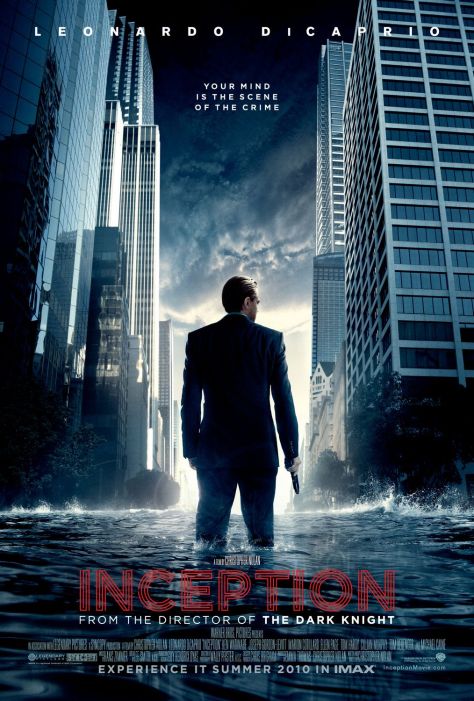

This is easily one of my favourite films of all time! Nolan creates a world that very few others can and tells a story that just gets your imagination running wild!
LikeLiked by 1 person
Totally agree. This film is so brilliantly conceived and executed in every way, I don’t think revisiting the in will ever get old.
LikeLike
I have to admit that I am a sucker for this kind of material. Play with the nature of reality, or ask whether someone is really in a dream, and you’re halfway to my heart.
Are you very familiar with the film Brazil? Because if it were not so dark, there’s a possibility that it would be my favorite film. As it stands it’s way too bleak, and does not match my philosophy, but it’s brilliant just the same.
About 20 or 30 minutes before the film ends, there are several shots of the protagonist, Sam Lowry, next to a mirror, and just before a huge explosion happens (that changes the course of the movie) Terry Gilliam does something weird: he inserts the briefest of shots of Sam next to the mirror, but the frame has been reversed.
I’ve always taken this to be a “Through the Looking Glass” moment, a signal that a break from reality is coming. IMO, everything that happens to Sam after that scene is over, right up until the second-to-last shot of the movie, takes place inside his head, even the stuff that’s supposed to be “real,” before the obvious dream sequence.
As long as this sort of thing has a point, like it does in Brazil, it’s fun. It’s easy for a film to devolve into being pointlessly convoluted, though. You already know how I interpret the end of Inception, but I just want to stress that I’m not saying Nolan doesn’t know the answer. I’ve spent time trying to figure out the answer myself. But at the end of the day, it is academic, the issue is that it matters not. Great, fantastic movie, don’t know if it’s his masterpiece, that’s kind of like trying to pick out Hitchcock’s masterpiece. Wait, Vertigo. OK, it might be Nolan’s masterpiece. This, or The Prestige.
LikeLiked by 1 person
I’ve seen Brazil, but it didn’t really blow me away. A lot of it seemed weird for weird’s sake, and we are talking about Terry Gilliam (whom I know you love), but even so. Inception, to me, is an example of a perfect movie. Not just a 10/10, but a movie that will still resonate with me and entertain me for the rest of my life. It’s the kind of film, you watch 1000 movies to see one of. Between rewatching that to write this piece, and binging on the SyFy’s awesome 12 Monkeys series….I’m having some series causality issues in my head this weekend lol.
LikeLiked by 1 person
So the 12 Monkeys series is good? Because co-opting a cinematic masterpiece by a rare science fiction auteur… it doesn’t sit well.
Everything in Brazil is there for a reason. It makes more sense to me than most police dramas. “It’s only a state of mind” was the tagline from when the film was marketed back in the day, and it’s amazing that the advertisers got it so right. The film is set nowhere, it’s just about wanting to bang your head against a wall, and finding other ways to cope instead.
Brazil is not about the future; no doubt people will enjoy it in the future, but Gilliam was inspired while reading about the Salem witch trials. The satire fits a lot of places and times; Gilliam only set it in the 20th century, in the western hemisphere, because the kind of horrifying, institutionalized stupidity/insanity shown in the film has reached its apex in our present place and day, or so it seems. But I say give it some time.
Sorry for co-opting your comment section to talk about Brazil.
Inception rules!
LikeLiked by 1 person
Oh we can talk about anything in the comments, and YES, it takes an episode or two, but by midway through season one, you’re hooked. It doesn’t try to connect to the film other than to use its premise, but it has very clever, intricate writing and I’ve blown through 17 episodes in two days if that’s any indication. SyFy with Magicians and The Expanse, has some truly fantastic series, which will be contenders in next month’s Best Show on TV poll.
LikeLike
I have to be honest. I watched the first episode of the Expanse, and while the level of the effects work and the visual world building was amazing for a tv show to say the least, I do not understand all the praise the show is getting, unless it noticinly improves. I thought the script was horribly unoriginal and filled with cliches. It’s not just me, I watched it with a friend and he felt the same way.
LikeLiked by 1 person
I think it does improve. Magicians is fricking brilliant.
LikeLike
This film epitomises the term, ‘down the rabbit hole’. 😀
LikeLiked by 1 person
Widders! Oh you have no idea; like I was telling Peter, I rewatched this to write the article and then I’ve also been binging on 12 Monkeys the series all weekend so I’m not really even sure in which timeline I’m replying to your comment….where’s my totem???
LikeLiked by 1 person
Heh, heh, heh. 😀
LikeLike